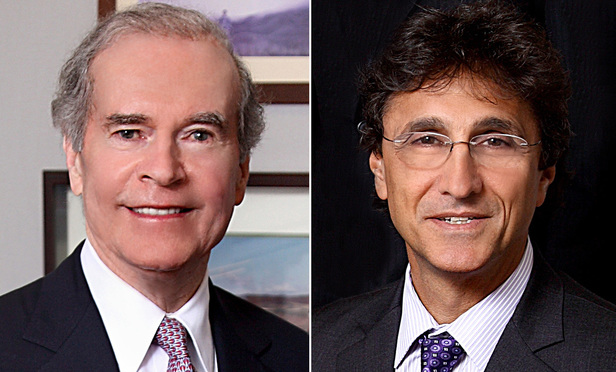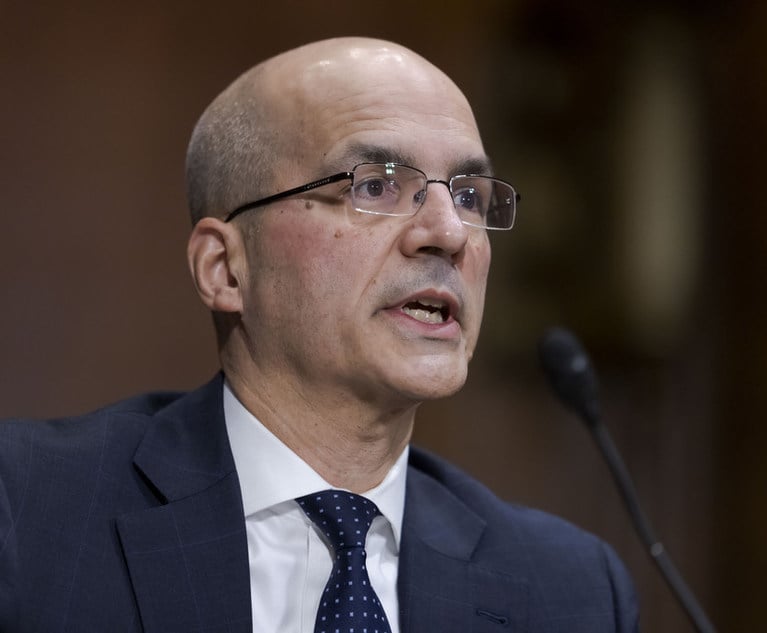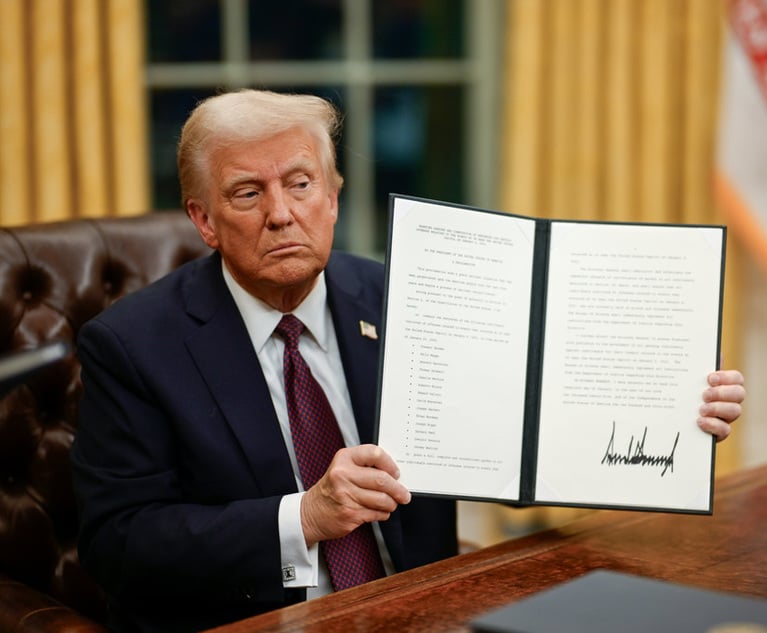The Emergency Doctrine Revisited
The theory behind the common law "emergency doctrine" is that a person in such a situation cannot reasonably be held to the same accuracy of judgment or conduct as someone who has an opportunity to reflect, even if the decision turns out to be wrong. The need for the emergency doctrine has been called into question in recent years based on principles of comparative negligence and the ability of juries to apportion fault. As Thomas A. Moore and Matthew Gaier discuss in this edition of their Medical Malpractice column, while some states have abolished the doctrine altogether, New York has not gone so far.
February 03, 2020 at 12:00 PM
13 minute read
 Thomas A. Moore and Matthew Gaier
Thomas A. Moore and Matthew Gaier
The emergency doctrine is a common law rule premised on the understanding "that when an actor is faced with a sudden and unexpected circumstance which leaves little or no time for thought, deliberation or consideration, or causes the actor to be reasonably so disturbed that the actor must make a speedy decision without weighing alternative courses of conduct, the actor may not be negligent if the actions taken are reasonable and prudent in the emergency context." Rivera v. New York City Tr. Auth., 77 N.Y.2d 322, 327 (1991); see also Lifson v. City of Syracuse, 17 N.Y.3d 492, 497 (2011); Caristo v. Sanzone, 96 N.Y.2d 172, 174 (2001). The theory behind the doctrine is that a person in such a situation cannot reasonably be held to the same accuracy of judgment or conduct as someone who has an opportunity to reflect, even if the decision turns out to be wrong. See Lifson, 17 N.Y.3d at 497; Caristo, 96 N.Y.2d at 174; Rivera, 77 N.Y.2d at 327. The need for the emergency doctrine has been called into question in recent years based on principles of comparative negligence and the ability of juries to apportion fault. See Lifson, 17 N.Y.3d at 497; Caristo, 96 N.Y.2d at 174. While some states have abolished the doctrine altogether, New York has not gone so far.
More than a decade has passed since we addressed the emergency doctrine in the context of medical malpractice actions. See Moore & Gaier, Emergency Doctrine: Limited Applicability to Malpractice, NYLJ (Aug. 1, 2007), p. 3. As we then noted, it has very limited applicability in such cases. To date, only a handful of appellate decisions have addressed the issue in the context of medical malpractice, and none have expressly found it applicable. The two most recent Appellate Division decisions addressing the issue have not altered that trend.
Before turning to those cases, it is pertinent to understand the impact of the emergency doctrine in the cases in which it applies. Most commonly, the issue arises in the context of a jury instruction. Under the emergency doctrine, if, "under some reasonable view of the evidence, an actor was confronted by a sudden and unforeseen occurrence not of the actor's own making, then the reasonableness of the conduct in the face of the emergency is for the jury, which should be appropriately instructed." Rivera, 77 N.Y.2d at 327. Accordingly, where the doctrine is applicable, it gives rise to a jury instruction under PJI 2:14.
The dispositive question in determining whether such an instruction is warranted is whether the proponent of the charge was faced with a "qualifying emergency." In Rivera, the court held that there was a qualifying emergency such that the charge should have been given in an action involving a person who fell off a subway platform and was killed by a train based on evidence that he fell suddenly and that the entire incident unfolded within seconds. In Caristo, which involved a motor vehicle accident that occurred when the defendant driver hit a sheet of ice and could not stop, there was no qualifying emergency and the charge was erroneously given because the driver was aware of weather conditions that could give rise to icy roads. An emergency doctrine charge was similarly found improper in Lifson, since there was no qualifying emergency based on the defendant driver being suddenly blinded by glare from the sun, because it should not be unexpected that the sun may interfere with a driver's vision in a vehicle heading west at sunset.
In addition to a jury instruction, the emergency doctrine sometimes arises in summary judgment motions. For instance, where a plaintiff moves for summary judgment on the issue of liability, a defendant may defeat the motion by raising an issue of fact as to whether the emergency doctrine is a defense. See, e.g., Rock-Wright v. O'Connor, 172 A.D.3d 1507 (3d Dept. 2019); Richards v. Mitchell, 172 A.D.3d 439 (1st Dept. 2019); Chwojdak v. Schunk, 164 A.D.3d 1630 (4th Dept. 2018). A defendant may also obtain summary judgment dismissing an action by establishing that liability is precluded under the emergency doctrine as a matter of law. See, e.g., MacMonigle v. Delbuono, 173 A.D.3d 1000 (2d Dept. 2019); Redrovan v. New York City Tr. Auth., 165 A.D.3d 465 (1st Dept. 2018); Marx v. Kessler, 145 A.D.3d 1618 (4th Dept. 2016); Foster v. Kelly, 119 A.D.3d 1250 (3d Dept. 2014). A motion on this ground requires a showing that the defendant was confronted with an emergency situation to which he or she did not contribute, and that his or her response was reasonable and prudent under the circumstances. See White v. Connors, 177 A.D.3d 1250 (4th Dept. 2019); Collins v. Suraci, 110 A.D.3d 1214 (3d Dept. 2013).
The decisions addressing the emergency doctrine in medical malpractice actions have usually involved questions of whether a jury instruction regarding the doctrine was warranted. It is important to note in this regard that the emergency doctrine charge under PJI 2:14 is to some extent at odds with the malpractice charge under PJI 2:150. PJI 2:14 provides, in part, that "[a] person faced with an emergency and who acts without opportunity to consider the alternatives is not negligent if (he, she) acts as a reasonably prudent person would act in the same emergency, even if it later appears that (he, she) did not make the safest choice or exercise the best judgment." PJI 2:150 provides, in part, that "[a] doctor must also use his or her best judgment … ." This contradiction renders the PJI emergency doctrine instruction problematic in a malpractice action, and in need of modification if such a charge were found to be warranted.
The first decision in a malpractice action to expressly address the emergency doctrine was Mertsaris v. 73rd Corp., 105 A.D.2d 67 (2d Dept. 1984), which involved claims that the infant plaintiff sustained neurologic injury around the time of his birth as a result of malpractice during the labor and delivery and during the efforts to resuscitate him. The emergency doctrine was invoked by the anesthesiologist who performed the resuscitation because the baby was born with no spontaneous respirations and required vigorous resuscitation. The claims against the anesthesiologist included failing to immediately intubate the child, using an Ambu bag in an improper manner, negligently administering medication, failing to properly monitor the baby's heart rate, and leaving the baby unattended for 30 minutes before the pediatrician arrived. While ordering a new trial on other grounds, the majority rejected the argument that an emergency doctrine charge was warranted, noting that the anesthesiologist was trained to deal with the very situation that arose, that it was sudden but not unforeseen, and that he was in an operating room and did not claim that he was lacking any necessary equipment.
In Kahl v. Loffredo, 221 A.D.2d 679 (3d Dept. 1995), which involved a claim that the defendant negligently repaired an episiotomy that extended into the plaintiff's rectum, the Appellate Division rejected the defendant's argument that an emergency doctrine charge was required. It found that, based upon the evidence that he lost the needle in the plaintiff's tissue during the repair, he was not confronted by a sudden and unforeseen occurrence that was not of his own making.
In Amodeo v. Cumella, 41 A.D.3d 396 (2d Dept. 2007), an obstetrical malpractice action involving claims of negligence in addressing shoulder dystocia, the Appellate Division found that it was reversible error to give an emergency doctrine charge based on evidence that the shoulder dystocia presented an obstetrical emergency. Since the evidence established that obstetricians are trained and prepared for that occurrence and that it happens with a fair amount of frequency, the court found that it was not unforeseen and that the charge was, therefore, inappropriate.
The most recent appellate decision addressing the emergency doctrine in a malpractice action was in Crayton v. Sher, 167 A.D.3d 705 (2d Dept. 2018), which stemmed from the death of a patient several days after undergoing spinal surgery. Five days after the surgery, the patient had swelling in her neck, which required that a hole be cut into her windpipe and a tracheostomy tube inserted to enable her to breathe. Three days later, a nurse and respiratory therapist encountered difficulty while removing a valve that enabled the patient to speak with a tracheostomy tube in place, and the patient began to experience shortness of breath. They attempted to suction the tube and ventilate the patient manually with an Ambu bag, but her oxygen saturation dropped to the low 60s and her level of consciousness rapidly decreased.
When the defendant anesthesiologist, Dr. Sher, arrived in response to a page, the patient's oxygen saturation was down to 45%, and she had become cyanotic and bradycardic. He testified that he suspected blockage of the tube by a mucus plug, but was reluctant to remove the tube because the hole might close and that the patient's halo brace and the swelling she was having would further complicate replacing the tube. The otolaryngologist who originally inserted the tube recommended over the phone that the tube be removed and the physician assistant at the bedside was prepared to insert a new tube. Dr. Sher nevertheless attempted conservative measures, and requested assistance from another anesthesiologist in retrieving a fiberoptic bronchoscope from another part of the hospital. However, when the patient's condition continued to decline, Dr. Sher removed the blocked tube and successfully replaced it within 30 seconds. The patient died that evening.
Based upon the emergent circumstance with which he was faced, the trial court granted the anesthesiologist's request for an emergency doctrine charge. On appeal from a verdict in favor of the defendants, the Appellate Division found that this was reversible error. The court explained:
The emergency doctrine "has been reserved, in a medical context, to situations where a doctor is confronted by a 'sudden and unforeseen condition' and is forced to undertake care under less than optimal circumstances," and is inapplicable where the defendant physician was trained and prepared for the specific emergency (Mertsaris v. 73rd Corp., 105 AD2d 67, 87 n 3 [1984]; see Amodeo v. Cumella, 41 AD3d 396, 398 [2007]). Here, there is no dispute that it was foreseeable for secretions to block a tracheostomy tube and that Sher was qualified as an anesthesiologist to replace a blocked tracheostomy tube. Indeed, Sher admitted that, in his 30 years of experience, creating airways for patients is what anesthesiologists do. Further, Sher was advised by [the physician assistant] that a mucus plug was blocking the tracheostomy tube which Sher was ultimately able to replace within seconds. Accordingly, there was no sudden and unforeseen condition for which Sher was not trained or prepared.
This decision underscores the limited nature of applicability of the emergency doctrine in cases involving medical malpractice. While Dr. Sher was clearly presented with an emergency that was not of his making, it could not have been an unforeseeable situation because it is his job to deal with precisely that type of emergency. The standards of care applicable to anesthesiologists confronted with blocked airways necessarily contemplate emergencies, and they cannot properly be afforded a lower standard of care based upon the emergent circumstance.
The same applies to all other medical specialties in which medical emergencies are foreseeable. The most obvious example is emergency room physicians. If they were entitled to an emergency doctrine charge because they were addressing emergent situations, the reduced standard sanctioned by the charge would literally swallow the standard of care prescribed by the profession. This applies to all physicians that are confronted with medical emergencies for which they are trained. It should therefore be exceedingly rare that an emergency doctrine charge is warranted in medical malpractice actions.
The other more recent appellate decision addressing the emergency doctrine in the context of failing to properly provide medical care is Andrews v. County of Cayuga, 96 A.D.3d 1477 (4th Dept. 2012), which involved a claim by a jail inmate that the defendant deprived him of prescription medications, failed to provide him medical services within the standard of care, and failed to exercise care and prudence during the care and treatment of a medical emergency. He alleged that as a result of being deprived of his medication he suffered a seizure, after which he had injuries to both of his shoulders. The decision did not involve a trial or a requested jury instruction but a motion for summary judgment by the defendant. One of the grounds asserted by the defendant in making the motion was that it should be relieved of liability as a matter of law based upon the emergency doctrine.
Although the decision does not specify the defendant's basis for that assertion, a review of the defendant's appellate brief indicates that they argued that the evidence established that the only contact between the deputies and the plaintiff's arms or shoulders occurred when they were attempting to restrain him while he was having a seizure, and that their actions "constituted a reasonable response to an urgent 'code blue' medical emergency." The defendant proffered two justifications for the deputies to grab and hold the plaintiff's arms: (1) he was still on his bunk when he was shaking violently and uncontrollably, and it was therefore reasonable and instinctive for them to prevent him from tumbling floor; and (2) it was reasonable for them to secure his arms so that the nurse could assess his condition.
The Appellate Division found this insufficient to establish as a matter of law that the defendant should be relieved of liability based on the emergency doctrine, observing that it is generally a question for the trier of fact to determine whether an emergency existed and, if so, whether the defendant's response thereto was reasonable.
Inasmuch as an emergency doctrine jury instruction will rarely be warranted in malpractice actions, it hard to fathom a defendant in such an action ever being entitled to summary judgment on the ground that the doctrine precludes its liability as a matter of law. In fact, since the plaintiff in Andrews claimed that he suffered his seizure as a result of the defendant's medical negligence, the defendant in that case would not even be entitled to an emergency doctrine instruction.
Thomas A. Moore is senior partner and Matthew Gaier is a partner of Kramer, Dillof, Livingston & Moore.
This content has been archived. It is available through our partners, LexisNexis® and Bloomberg Law.
To view this content, please continue to their sites.
Not a Lexis Subscriber?
Subscribe Now
Not a Bloomberg Law Subscriber?
Subscribe Now
NOT FOR REPRINT
© 2025 ALM Global, LLC, All Rights Reserved. Request academic re-use from www.copyright.com. All other uses, submit a request to [email protected]. For more information visit Asset & Logo Licensing.
You Might Like
View All
'A Shock to the System’: Some Government Attorneys Are Forced Out, While Others Weigh Job Options
7 minute read
'Serious Legal Errors'?: Rival League May Appeal Following Dismissal of Soccer Antitrust Case
6 minute read
How Some Elite Law Firms Are Growing Equity Partner Ranks Faster Than Others
4 minute read
Trending Stories
Who Got The Work
J. Brugh Lower of Gibbons has entered an appearance for industrial equipment supplier Devco Corporation in a pending trademark infringement lawsuit. The suit, accusing the defendant of selling knock-off Graco products, was filed Dec. 18 in New Jersey District Court by Rivkin Radler on behalf of Graco Inc. and Graco Minnesota. The case, assigned to U.S. District Judge Zahid N. Quraishi, is 3:24-cv-11294, Graco Inc. et al v. Devco Corporation.
Who Got The Work
Rebecca Maller-Stein and Kent A. Yalowitz of Arnold & Porter Kaye Scholer have entered their appearances for Hanaco Venture Capital and its executives, Lior Prosor and David Frankel, in a pending securities lawsuit. The action, filed on Dec. 24 in New York Southern District Court by Zell, Aron & Co. on behalf of Goldeneye Advisors, accuses the defendants of negligently and fraudulently managing the plaintiff's $1 million investment. The case, assigned to U.S. District Judge Vernon S. Broderick, is 1:24-cv-09918, Goldeneye Advisors, LLC v. Hanaco Venture Capital, Ltd. et al.
Who Got The Work
Attorneys from A&O Shearman has stepped in as defense counsel for Toronto-Dominion Bank and other defendants in a pending securities class action. The suit, filed Dec. 11 in New York Southern District Court by Bleichmar Fonti & Auld, accuses the defendants of concealing the bank's 'pervasive' deficiencies in regards to its compliance with the Bank Secrecy Act and the quality of its anti-money laundering controls. The case, assigned to U.S. District Judge Arun Subramanian, is 1:24-cv-09445, Gonzalez v. The Toronto-Dominion Bank et al.
Who Got The Work
Crown Castle International, a Pennsylvania company providing shared communications infrastructure, has turned to Luke D. Wolf of Gordon Rees Scully Mansukhani to fend off a pending breach-of-contract lawsuit. The court action, filed Nov. 25 in Michigan Eastern District Court by Hooper Hathaway PC on behalf of The Town Residences LLC, accuses Crown Castle of failing to transfer approximately $30,000 in utility payments from T-Mobile in breach of a roof-top lease and assignment agreement. The case, assigned to U.S. District Judge Susan K. Declercq, is 2:24-cv-13131, The Town Residences LLC v. T-Mobile US, Inc. et al.
Who Got The Work
Wilfred P. Coronato and Daniel M. Schwartz of McCarter & English have stepped in as defense counsel to Electrolux Home Products Inc. in a pending product liability lawsuit. The court action, filed Nov. 26 in New York Eastern District Court by Poulos Lopiccolo PC and Nagel Rice LLP on behalf of David Stern, alleges that the defendant's refrigerators’ drawers and shelving repeatedly break and fall apart within months after purchase. The case, assigned to U.S. District Judge Joan M. Azrack, is 2:24-cv-08204, Stern v. Electrolux Home Products, Inc.
Featured Firms
Law Offices of Gary Martin Hays & Associates, P.C.
(470) 294-1674
Law Offices of Mark E. Salomone
(857) 444-6468
Smith & Hassler
(713) 739-1250






